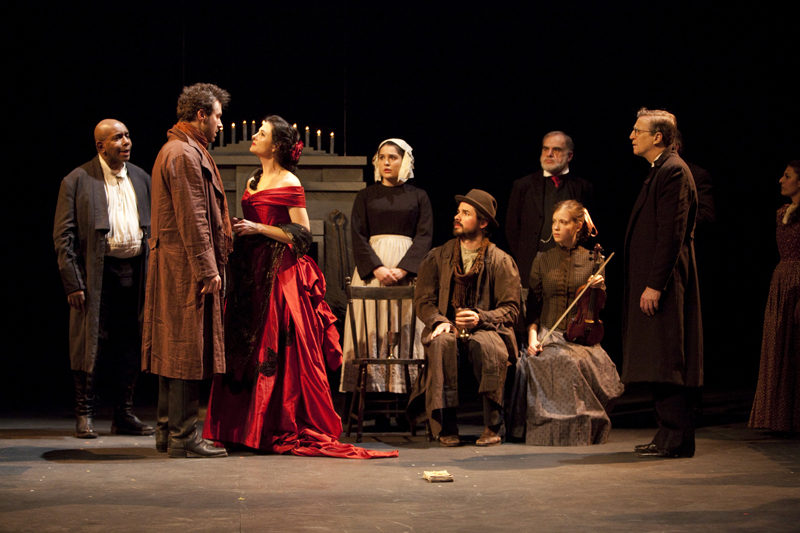The Idiot

"The Idiot," a new adaptation of Dostoevsky's novel written by James Fagan Tait and produced by Neworld Theatre and Vancouver Moving Theatre, opened on January 20, 2012 as part of the PuSh Festival, at UBCs Frederic Wood Theatre. Cleverly scripted and tightly-paced, the three-and-a-half-hour performance casts a vivid spell, so much so that its lengthy narrative journey feels both necessary and natural.
It's a credit to Tait and to the cast that the play manages both lightness and weight: Russian novels are notoriously detailed, ponderous, and tragic (though this reputation is oten due to modern readers missing some of the wit in the writing, I think). Tait's adaptation retains a crafted, literary aura, but also injects humour and energy into the work. Some of the lightness comes from the the script, which is unabashedly contemporary. It skirts the edge of parody with its pithy colloquialisms, but retains a brooding, soul-searching undertone that does credit to the larger narrative. The actors' comic timing is also important: on opening night, when characters faced-off swearing, or delivered lines that were ironically leaden and literal, their body language and chemistry paid off – Friday's audiece laughed consistently throughout the show.
"The Idiot" supports a large cast – 21 performers. They are put to good use: Dostoevsky's characters are brough to life through the stories that they tell. Several times as one character engaged in monologue, others would breakout and re-enact the tale: participating in a macabre party game, General Ypanchin tells a story about mistreating an old woman during his younger days in the military. Another castmember illustrates his words, bringing the story into a Russian aristocrat's livingroom. When the lead character, Prince Lyov Nikolayevich Myshkin, arrives in St. Petersburg, the ensemble is arrayed around him, rocking gently to the imaginary rhythm of the train. In the second act the Prince, while in the midst of an epileptic seizure, has an epiphany about the nature of love, fear and pity. Once again, the motley cast (dressed throughout as peasants, aristocrats, servants, etc.) gather around him. Massed like a group of passengers queqed for tickets, they begin to sing, narrating his inner monologue, while the lights above flicker like a storm, mimicing the effects of his fit.
Just as importantly as the script, this amorphous body of performers served to give texture to the play: they represented the many threads of story and characer that are woven into a realist novel like The Idiot. Without them, the play would have felt much more like an abridged version of an epic story, told in a truncated form. As it was, this dramatization was rich and episodic, and it integrated a multitude of characters and themes in a way that felt like a honest homage to its source.
Overall, I was delighted by the economy with which this vast set of characters and locations was represented. Comic figures, like the General, Lady Ypanchin, and the memorably flaming Ferdyshenko, add to the action around Myshkin's story. Yet they share tight repartee with other lesser figures, showing in a few quick strokes that they are independent characters with their own agendas. The young Ypanchin girls are given one major scene to anchor themselves in our minds, which they do with facial expressions and the few details given in a moment of exposition. Locations are painted with equal clarity: silhouettes on the train or light from a windowpane on the floor and a bare wooden chair to represent the Prince's room. A great deal of attention is given to the details of costume – colours linking families, simple planes for the Yepanchin girls' clothes, various of the cast in overcoats, vests, leather boots, and watch chains, flowers in women's hair, hats, and damasked scarves. These textures allow us to visually fill in the gaps, imagining a full cross-section of Russian society.
Many themes circulate around Prince Myshkin, the sickly, sweet-natured, uncorruptable “idiot” – from an expose of cynicism in Russian society and the role of religion in civic life, to the large question of how compassion, romantic love, and fraternity are related. The core of the tale is, however, the love triangle between Myshkin; kept woman and femme fatale Nastassya Filippovna; and uncouth, hotblooded rake Rogozhin. Nastassya is the pivot around which the story turns, and her depiction is handled nicely: long before we see her on the stage, we hear about her from other characters. When she is introduced it is with a sweet, sorrowful leitmotif that foreshadows her inevitable tragic end. Costumed in red and black, as befits a “fallen” woman, and still later dressed in ghostly white in Myshkin's fnatasies, she is always a brilliant apparition – too beautiful, too deadly, too lost. Cherise Clarke's performance is appropriately understated – she is passionate, but also delicate – she rages, seems about to cannibalize herself with her own fury, only to withdraw into cold silence, emiting an aura of melencholy.
As Prince Myshkin, Kevin McDonald has the job of driving the plot. His delivery is mild and sincerity shines from his open face, but his timing is deft, so that the of the momentum of the story seldom flags. As Rogozhin, Andrew McNee has less opportunity to show a range of emotion, but he still offers a dynamic performance – sometimes he is simply brash, but elsewhere his swaggering machismo is deadpan-ironic – relishing the role of the troublemaker he plays it for all it's worth.
"The Idiot" takes some risks, with its lengthy running time and large ensemble. But each element is well thought-out and adds something important to the whole. The only critique I can level is that the early part of Act Two seemed to drag a little: after the rush of introductions establishing the characters in Act One, we jump ahead a year – Nastassya and the Prince have lived together and parted, the Prince is wooing one of the Ypanchin daughters, Aglaya, etc – the audience needs to absorb a lot of action after the fact, and these scenes feel a bit stogy.
Things pick up again though, as the Prince and Rogozhin, and Nastassya and Aglaya head towards cofrontations that excavate deeper facets of their personalities. And any tragic obsession or bloodlust that audience members harbour in their hearts is fully quenched by the end of the show. This is a thoughtful adaptation of Dostoyovsky's novel and it stands alone as a complete and satisfying piece of theatre.



